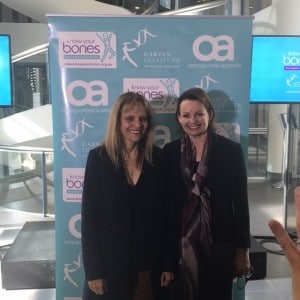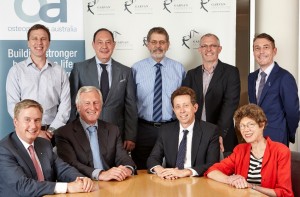Don’t be bone idle – Experts launch assessment tool to help curb bone fractures – June 16, 2016
New figures reveal a bone break every 3.4 minutes due to poor bone health
An Australian-first bone health self-assessment tool designed to help consumers understand their bone fracture risk, is now available to all adults, including the 7.5 million Australians living with brittle bones.1
The ‘Know Your Bones’ online tool – an inaugural Garvan Institute of Medical Research and Osteoporosis Australia joint initiative – helps adults assess their likelihood of fractures, including those diagnosed with osteopenia and osteoporosis – two common bone conditions that, together with fractures, will cost the nation more than $3 billion this year.2
The evidence-based, consumer-friendly tool summarises bone fracture risk by assessing age, gender, weight, history of fracture, bone mineral density, and history of falls and lifestyle factors within the past 12 months. Risk of fracture over five and 10 years respectively, is assessed for people aged 50 and above, and a general, actionable summary is provided for all users (aged 18 and above), for further discussion with their GP.
The launch of the innovative tool coincides with today’s release of new Osteoporosis Australia fracture figures revealing more than 155,000 fractures will occur Australia-wide this year,2 with a bone broken every 3.4 minutes due to poor bone health.2 Furthermore, men will account for up to 30 per cent of all fractures related to osteopenia and osteoporosis, and their associated costs. In 2016, the total annual cost of fractures is estimated to be $2.075 billion.2
According to Professor Jacqueline Center, Garvan Institute of Medical Research, Sydney, the Know Your Bones project is based on key research findings from the 26-year-long Dubbo Osteoporosis Epidemiology Study, the world’s longest-running, large-scale, osteoporosis study. The Dubbo study has been led, since inception, by researchers from the Garvan Institute of Medical Research’s Bone Biology Division, including Professor John Eisman AO, Professor Center and Professor Tuan Nguyen.
“The Dubbo study has confirmed that both men and women are affected by osteoporosis, and that bone loss continues in older age. The study has also revealed that once you fracture a bone as a result of poor bone health, the risk of breaking another bone doubles in women, and increases three-to-four-fold in men. Furthermore, there is a strong link between all major fractures and premature death.”
“Importantly, this study has allowed us to understand a person’s risk of fracture based on a combination of factors, which we have incorporated into the ‘Know Your Bones’ self-assessment tool,” Professor Center said.
 “Given the community’s thirst for credible health information, this innovative bone health self-assessment tool will offer consumers a simple summary of their fracture risk, which they can take to their GP for further discussion.”
“Given the community’s thirst for credible health information, this innovative bone health self-assessment tool will offer consumers a simple summary of their fracture risk, which they can take to their GP for further discussion.”
Federal Minister for Health, The Hon. Sussan Ley MP, said “the Know Your Bones health assessment tool is a great example of how medical research can be translated into a real community’s benefit, allowing anyone to better understand their own risk of fractures.
“I encourage all adults to take a few minutes out of one day, jump online and complete the Know Your Bones assessment.”
Professor Peter Ebeling AO, Medical Director, Osteoporosis Australia and Board Member of the International Osteoporosis Foundation, says osteoporosis reduces bone strength and increases the risk of fracture, particularly of the spine, hip and wrist.
“Osteoporosis and related fractures is an Australian national health priority.
“That’s why Osteoporosis Australia and the Garvan Institute of Medical Research today have joined forces, to place this practical, online self-assessment tool in the hands of the community, so they can be proactive about their bone health,” said Prof Ebeling.
Published author, wife and keen mother, Annarosa, 54, Sydney, has a strong family history of osteoporosis. On a Sunday morning walk in September 2010, Annarosa tripped over her bootlaces and landed heavily on her wrist. Despite experiencing excruciating pain, Annarosa was determined to walk the five blocks home. On her way home however, and in the absence of a mobile phone, she entered a local corner store for help, where she contacted her husband, who drove her to hospital emergency.
her bootlaces and landed heavily on her wrist. Despite experiencing excruciating pain, Annarosa was determined to walk the five blocks home. On her way home however, and in the absence of a mobile phone, she entered a local corner store for help, where she contacted her husband, who drove her to hospital emergency.
She was subsequently admitted to hospital, and underwent an X-ray that confirmed a fractured wrist. After returning home for a few days to allow the swelling to subside, Annarosa returned to hospital to have her wrist set in plaster and to undergo a bone mineral density scan which revealed osteoporosis in her hip and spine.
“That’s when I discovered that my bones were not healthy at all – in fact, they were much weaker than the rest of me,” Annarosa said.
“When I was diagnosed with osteoporosis, I was really surprised and a bit upset – I was only 48 at the time, and I had not considered it was a disease that people of my age developed.
“Fortunately, we caught th e disease early, so were able to commence treating it, and to care for, and improve the strength of my bones,” said Annarosa.
e disease early, so were able to commence treating it, and to care for, and improve the strength of my bones,” said Annarosa.
Annarosa urges all adult Australians to get to know their bone health, by using the Know Your Bones online health assessment tool, “because anything that offers protection against developing brittle bones and sustaining a fracture is worth five minutes of your time.”
Osteoporosis Australia CEO, Greg Lyubomirsky, said Australians should regard these new fracture figures as a public health warning.
“Two-thirds of Australians aged 50 and above, have poor bone health and many don’t know it, even when they have obvious risk factors, or have experienced a previous fracture. Unfortunately, only around 20 per cent of those women who sustain a fracture and go to hospital, are either treated or properly investigated for osteoporosis. Even fewer men are followed up appropriately.
“Poor bone health can lead to fractures. Don’t wait to break a bone, take the Know Your Bones health assessment today,” Mr Lyubomirsky said.
The Know Your Bones fracture risk self-assessment takes only five minutes. Simply visit www.knowyourbones.org.au, print out a report and take it to your doctor to discuss your risk and a suitable action plan.
It’s estimated that 1.2 million Australians are living with osteoporosis and 6.3 million have low bone density. Osteoporosis affects women and men, and occurs when bones lose their density and quality, weakening the skeleton. Osteoporosis can affect almost any of your body’s 206 bones, though fractures most often occur in the hip, spine, wrist, ribs, and pelvis. However, the Know Your Bones tool can help people understand when they may need to speak to their GP about managing risks, proper medical investigation and management can approximately halve the risk of further fracture.4
Risk factors for osteoporosis include a family history of the disease, fractures from minimal trauma, low bone density and falls. Medical risk factors include low body weight, early menopause, low testosterone, inflammatory conditions, malabsorption disorders (such as coeliac disease), corticosteroid use (e.g. for asthma), some cancer treatments (particularly for breast and prostate cancer), loss of height (3 cm or more), overactive thyroid and parathyroid conditions.5 Lifestyle issues include calcium and vitamin D deficiency, smoking, insufficient exercise and excessive alcohol consumption.
“To assess your risk of breaking a bone, go online, answer some questions and, most importantly, share your results with your doctor,” urged Helen Dalley, Patron of Osteoporosis Australia, whose mother battled osteoporosis, and who understands how disruptive a fracture can be on daily life, having personally sustained a hand fracture.
“Get to know your bones and stay fracture-free. Visit www.knowyourbones.org.au today.”
About the Bone Alliance
A new Bone Alliance between the Garvan Institute of Medical Research and Osteoporosis Australia was announced on World Osteoporosis Day 2015 (October 20) to address the major health issue of osteoporosis, using innovation and education to achieve positive change for bone health. The Know Your Bones health assessment tool represents the first project of this partnership.
References
- Henry MJ, Pasco JA, Nicholson GC, et al. Prevalence of osteoporosis in Australian men and women: Geelong Osteoporosis Study. Med J Australia 2011; 195:321-322 and ABS Australian Demographic Statistics.
- Sanders KM, Watts JJ, Abimanyi-Ochom J, Murtaza G. Osteoporosis: A Burden of Disease Analysis – Preliminary Data 2016 (national and State-specific). Osteoporosis Australia. 2016.
- Watts J, Abimanyi-Ochom J, Sanders K. Osteoporosis costing all Australians – A new burden of disease analysis 2012-2022. Osteoporosis Australia, 2013.
- Chen J, Sambrook P. Antiresorptive therapies for osteoporosis: a clinical overview. Nat Rev Endocrinol 2012; 8:81-91.
- Osteoporosis Australia. What you need to know about Osteoporosis. 2014.
